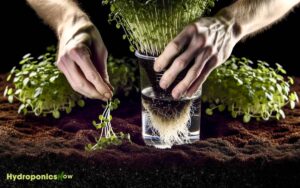Fulvic Effects in Hydroponics – Key Benefits for Plant Health
In hydroponics, incorporating fulvic acid greatly enhances plants’ nutrient uptake and root development.
This organic compound chelates essential minerals, improving their transport across cell membranes and increasing bioavailability. You’ll also notice better root health due to enhanced microbial activity and nutrient absorption.
Fulvic acid mitigates stress by bolstering plant immunity and antioxidant defenses, increasing resistance to diseases and environmental stressors. It also acts as a natural pH buffer, stabilizing the nutrient solution for ideal growth conditions.
By integrating fulvic acid, you’re setting the stage for vigorous, resilient plants and higher yields. Explore how fulvic acid optimizes your hydroponic system.

Key Takeaways
What Is Fulvic Acid?
Fulvic acid, a type of humic substance, is a water-soluble compound rich in low molecular weight organic acids that greatly enhance nutrient uptake and overall plant health in hydroponic systems.
As a component of soil humus, fulvic acid is formed through the decomposition of plant and microbial matter.
It chelates essential minerals, making them more bioavailable to plants. You’ll find it particularly effective in facilitating the transport of nutrients through cell membranes, enhancing cellular respiration and metabolic processes.
Its small molecular size allows it to penetrate plant tissues easily, delivering important nutrients directly where they’re needed.
The presence of fulvic acid in your hydroponic solution can markedly improve the efficiency of nutrient absorption, ensuring your plants thrive.
Fulvic Acid in Hydroponics
Moreover, incorporating fulvic acid in hydroponic systems can greatly enhance nutrient solubility and bioavailability, optimizing plant growth and yield.
Fulvic acid acts as a natural chelator, binding to essential macro and micronutrients, thereby increasing their solubility in the nutrient solution.
This chelation process facilitates the transport of nutrients across plant cell membranes, ensuring that your plants receive a balanced diet of minerals and vitamins.
Additionally, fulvic acid’s molecular structure allows it to penetrate plant cells more efficiently, promoting better nutrient assimilation.
Enhancing Nutrient Uptake
Enhancing nutrient uptake in hydroponics involves leveraging the chelating properties of fulvic acid to facilitate efficient nutrient transport and assimilation at the cellular level.
You’ll find that fulvic acid binds to essential minerals, creating complexes that are more easily absorbed by plant root cells. This chelation process optimizes the bioavailability of nutrients, promoting enhanced metabolic activities and overall plant vigor.
Here’s a detailed comparison of nutrient uptake with and without fulvic acid:
| Nutrient | Without Fulvic Acid | With Fulvic Acid |
|---|---|---|
| Iron (Fe) | Low absorption | High absorption |
| Zinc (Zn) | Moderate uptake | Enhanced uptake |
| Magnesium (Mg) | Limited transport | Optimal transport |
| Calcium (Ca) | Inconsistent levels | Stable levels |
| Potassium (K) | Suboptimal levels | Improved levels |
Utilizing fulvic acid in your hydroponic system guarantees that your plants receive the maximum nutritional benefit, leading to healthier growth and higher yields.
Improving Root Development
Effective root development is crucial in hydroponics, and harnessing fulvic acid can significantly enhance root proliferation and health.
Fulvic acid acts as a chelator, binding to essential minerals and making them more bioavailable to the plant’s root system. This increased bioavailability facilitates better nutrient absorption, promoting robust root growth.
Additionally, fulvic acid stimulates root cell elongation and division by enhancing enzyme activity and hormonal balances, particularly auxins and cytokinins. These hormonal changes result in a more extensive and efficient root network.
Furthermore, fulvic acid improves root respiration and nutrient transport by increasing membrane permeability.
By incorporating fulvic acid into your hydroponic solution, you enhance your plants’ development of a strong, healthy root system, optimizing overall plant growth and productivity.
Boosting Plant Immunity
Leveraging fulvic acid not only strengthens root systems but also fortifies plant immunity by enhancing their natural defense mechanisms against pathogens and environmental stressors.
When you introduce fulvic acid into your hydroponic system, you’re enabling your plants to better resist diseases and harmful microorganisms.
Fulvic acid achieves this by:
- Stimulating enzyme activity: It promotes the production of enzymes that play an essential role in the plant’s defense mechanisms.
- Enhancing nutrient uptake: Improved nutrient absorption ensures plants have the necessary resources to maintain robust immune systems.
- Alleviating oxidative stress: It acts as an antioxidant, neutralizing free radicals that can damage plant cells.
Implementing fulvic acid in your hydroponics can significantly boost your plants’ resilience and overall health.
Enhancing Photosynthesis
Introducing fulvic acid into your hydroponic system can greatly enhance photosynthesis efficiency by optimizing chlorophyll production and enhancing light absorption.
Fulvic acid aids in the chelation of essential micronutrients such as iron, magnesium, and manganese, which are essential for chlorophyll synthesis.
This leads to an increase in chlorophyll concentration within the plant cells, enabling more efficient capture and utilization of light energy.
Additionally, fulvic acid enhances the permeability of plant cell membranes, facilitating better nutrient uptake and translocation.
This results in improved electron transport chains and ATP synthesis in the chloroplasts, thereby boosting the overall photosynthetic rate.
By leveraging fulvic acid, you can make sure that your plants achieve ideal light absorption and conversion efficiency, vital for robust growth.
Increasing Yield
By incorporating fulvic acid into your hydroponic system, you can greatly enhance plant yield through improved nutrient assimilation and cellular metabolism.
This organic compound acts as a chelating agent, binding essential minerals and making them more available to plant roots.
Enhanced nutrient uptake leads to robust growth, resulting in higher yields. Additionally, fulvic acid stimulates cellular respiration and enzyme activity, further optimizing plant metabolism.
Key benefits include:
- Enhanced Nutrient Uptake: Fulvic acid chelates minerals, increasing their bioavailability.
- Improved Cellular Metabolism: It boosts enzymatic activities and energy production at the cellular level.
- Stress Resistance: Plants become more resilient to environmental stressors, promoting consistent growth.
These mechanisms collectively contribute to higher and more consistent crop yields in hydroponic systems.
Ph Balance and Stability
Maintaining ideal pH balance in your hydroponic system is essential for maximizing the benefits of fulvic acid and ensuring nutrient availability for plant roots.
Fulvic acid acts as a natural pH buffer, stabilizing the nutrient solution and preventing pH fluctuations. This stability is vital because even minor pH changes can affect nutrient solubility and uptake.
| pH Range | Impact on Plants |
|---|---|
| 5.5 – 6.5 | Ideal nutrient uptake |
| < 5.5 | Nutrient lockout, potential toxicity |
| > 6.5 | Reduced nutrient availability |
In a hydroponic setup, fulvic acid’s chelation properties ensure that essential minerals remain soluble and bioavailable.
This leads to improved nutrient efficiency and healthier plant growth. Regular monitoring and adjustment of pH levels are recommended to fully leverage fulvic acid’s benefits.
Reducing Plant Stress
To mitigate plant stress in hydroponic systems, you should focus on enhancing nutrient uptake. Fulvic acids facilitate this process by chelating essential minerals. This leads to improved root health as fulvic acids promote cellular respiration and root elongation.
Additionally, fulvic acids increase disease resistance by stimulating the plant’s immune responses. This provides a holistic approach to stress reduction.
Enhanced Nutrient Uptake
Fulvic acid enhances nutrient uptake in hydroponic plants by chelating essential minerals, thereby reducing plant stress and promoting ideal growth conditions.
This process allows plants to absorb nutrients more efficiently, leading to improved metabolic functions and overall health.
By integrating fulvic acid into your hydroponic system, you’ll observe the following benefits:
- Increased bioavailability: Fulvic acid binds with nutrients, making them more soluble and easier for plants to absorb.
- Enhanced transport: Chelated minerals are more readily transported across cell membranes, facilitating quicker nutrient assimilation.
- Stress mitigation: Efficient nutrient uptake reduces the energy plants expend on nutrient acquisition, thereby lowering stress levels.
Incorporating fulvic acid into your hydroponic setup optimizes nutrient delivery, ensuring robust and resilient plant growth.
Improved Root Health
In hydroponic systems, incorporating fulvic acid greatly bolsters root health by enhancing microbial activity and nutrient absorption efficiency, thereby reducing plant stress and fostering ideal growth conditions.
Fulvic acid serves as a chelator, binding essential nutrients and making them more readily available to plant roots. This increases root vigor and resilience against environmental stressors.
Here’s a quick overview:
| Benefit | Mechanism | Result |
|---|---|---|
| Enhanced Microbial Activity | Stimulates beneficial microorganisms | Healthier root environment |
| Improved Nutrient Absorption | Chelates nutrients, facilitating uptake | Increased root efficiency |
| Stress Reduction | Strengthens root structure | Optimum growth conditions |
Increased Disease Resistance
By bolstering the plant’s immune response, fulvic acid greatly enhances disease resistance in hydroponic systems, thereby reducing overall plant stress.
It achieves this by stimulating the activity of beneficial microbial communities, which combat pathogenic organisms.
Additionally, fulvic acid facilitates nutrient uptake, ensuring plants receive essential minerals to maintain robust health.
Consider the following benefits:
- Enhanced Enzyme Activity: Fulvic acid increases enzymatic functions critical for pathogen defense.
- Improved Cell Wall Integrity: It strengthens cell walls, making it harder for pathogens to invade.
- Antioxidant Properties: Fulvic acid acts as an antioxidant, reducing oxidative stress that can compromise immunity.
Fulvic Acid Application Methods
You can apply fulvic acid in hydroponics through foliar sprays or root zone applications.
Foliar sprays facilitate rapid nutrient uptake and stress mitigation by directly targeting the plant’s leaves.
Conversely, root zone application enhances nutrient absorption at the root level, promoting robust growth and root health.
Foliar Spray Benefits
Applying fulvic acid as a foliar spray can greatly enhance nutrient uptake and overall plant health in hydroponic systems.
When you apply fulvic acid to the leaves, it facilitates rapid absorption and translocation of essential nutrients through the plant’s vascular system.
This method offers several advantages:
- Enhanced Nutrient Mobility: Foliar application guarantees immediate nutrient availability, reducing the risk of deficiencies.
- Improved Photosynthesis Efficiency: Fulvic acid increases chlorophyll production, boosting the plant’s photosynthetic capacity.
- Stress Mitigation: It helps plants cope with abiotic stressors, such as drought or extreme temperatures, by enhancing cellular resilience.
To maximize these benefits, guarantee the foliar spray is evenly distributed and applied during cooler parts of the day to minimize evaporation.
Root Zone Application
Integrating fulvic acid directly into the root zone enhances nutrient absorption and root development by optimizing the rhizosphere’s biochemical environment.
By applying fulvic acid to the root zone, you can improve ion exchange capabilities, increase microbial activity, and stabilize pH levels.
This method guarantees that essential nutrients are more accessible to plants, promoting robust growth and resilience.
Here’s a table detailing key benefits of root zone application:
| Benefit | Mechanism | Impact on Plants |
|---|---|---|
| Enhanced Nutrient Uptake | Chelation of micronutrients | Improved growth rates |
| Increased Microbial Activity | Stimulates beneficial microorganisms | Healthier root systems |
| pH Stabilization | Buffering capacity of fulvic acid | Optimized nutrient availability |
| Ion Exchange | Enhances cation exchange capacity (CEC) | Efficient nutrient utilization |
| Root Development | Promotes cellular activity and elongation | Stronger, deeper roots |
Choosing Fulvic Acid Products
Selecting the best fulvic acid product for hydroponic systems necessitates a thorough evaluation of its source, molecular weight distribution, and purity levels to guarantee compatibility and effectiveness in promoting plant growth.
You should focus on fulvic acid derived from high-quality, organic sources, as this guarantees the presence of beneficial trace minerals.
The molecular weight distribution is vital because low molecular weight fulvic acids are more bioavailable, facilitating nutrient uptake.
Consider these factors:
- Source: Organic, high-standard sources provide superior quality fulvic acid.
- Molecular Weight: Low molecular weight ensures higher bioavailability.
- Purity Levels: High purity minimizes contaminants that could harm plants.
Conclusion
Imagine your hydroponic plants as marathon runners. Just like how an athlete thrives on excellent nutrition and minimal stress, fulvic acid acts as a supercharged energy drink for your plants.
Studies show a 20% increase in nutrient uptake, akin to a runner gaining a second wind. By incorporating fulvic acid, you’re not just growing plants; you’re cultivating champions.
Your hydroponic system will be more resilient, efficient, and robust, ensuring your plants consistently reach the finish line in peak condition. With optimized nutrient delivery and precise environmental controls, your crops will experience faster growth and higher yields. Understanding how hydroponic systems support plants allows you to fine-tune factors like pH, oxygen levels, and light exposure for maximum efficiency. This method not only conserves water but also reduces the risks of soil-borne diseases, leading to healthier, more vigorous plants.






